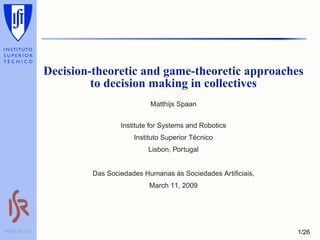
Decision-theoretic and game-theoretic approaches to decision making in collectives (Matthijs Spaan)
- 1. Decision-theoretic and game-theoretic approaches to decision making in collectives Matthijs Spaan Institute for Systems and Robotics ´ Instituto Superior Tecnico Lisbon, Portugal ` Das Sociedades Humanas as Sociedades Artificiais, March 11, 2009 PÓLO DO I.S.T 1/26
- 2. Introduction • Our research goal: “intelligent” decision making for robots in collectives. • Here: intelligent = rational given a task. • Examples: ◮ Robots to assist people; ◮ Multi-robot search and rescue; ◮ Robots playing football; ◮ Software agents on the internet. PÓLO DO I.S.T 2/26
- 3. Artificial Societies vs. Human Societies • Our perspective: design artificial systems with a purpose. • Robot societies need not resemble human societies. • Humans: not fully rational. • Robots: hopefully more rational. PÓLO DO I.S.T 3/26
- 4. Rational robots • Rational robots do the right thing. ◮ Knowledge of the environment. ◮ Actions the robot can take. ◮ Perceptions seen so far. ◮ Performance measure. PÓLO DO I.S.T 4/26
- 5. Rational paths PÓLO DO I.S.T 5/26
- 6. Limited rationality PÓLO DO I.S.T 6/26
- 7. Rational behavior • Don’t program how the robot should behave. • Program its environment, actions, perceptions, performance measure. ⇒ Robot will behave rationally. • Equip robot with tools to behave rationally. PÓLO DO I.S.T 7/26
- 8. Utility • Utility: degree of happiness. • If a robot prefers one situation over another one, it has higher utility. • Utility function: utility of each situation. • We define our robot’s utility function. PÓLO DO I.S.T 8/26
- 9. Utility Gold More Gold Recharge Point Lion PÓLO DO I.S.T 9/26
- 10. Utility Utility = +0 PÓLO DO I.S.T 10/26
- 11. Utility Utility = +10 PÓLO DO I.S.T 11/26
- 12. Utility Utility = +30 PÓLO DO I.S.T 12/26
- 13. Utility Utility = −100 PÓLO DO I.S.T 13/26
- 14. Utility Battery high ⇒ Utility = +0 Battery low ⇒ Utility = +10 Battery very low ⇒ Utility = +100 PÓLO DO I.S.T 14/26
- 15. Maximizing Utility • Rational robots maximize utility over their lifetime. • Robots needs to consider sequential decisions. • Maximize benefits while minimizing costs. • Each action uses energy. PÓLO DO I.S.T 15/26
- 16. Maximizing Utility PÓLO DO I.S.T 16/26
- 17. Maximizing Utility Utility: 5 ∗ −1 + 10 = 5 Utility: 3 ∗ −1 + 10 = 7 −1 −1 −1 −1 +10 +10 −1 −1 −1 −1 PÓLO DO I.S.T 17/26
- 18. Maximizing Utility Utility: 4 ∗ −1 + 20 = 16 Utility: 2 ∗ −1 + 10 = 8 +20 +10 PÓLO DO I.S.T 18/26
- 19. Maximizing Utility Utility: 2 ∗ −1 − 100 + 20 = −82 Utility: 3 ∗ −1 + 10 = 7 Utility: 5 ∗ −1 + 20 = 15 −100 +20 +10 PÓLO DO I.S.T 19/26
- 20. Uncertainty • Things don’t always work out as you want. . . • Robots need to deal with noise. • Uncertainty complicates maximizing utility. PÓLO DO I.S.T 20/26
- 21. Maximizing Utility under Uncertainty safe path dangerous path +10 +20 −20 −20 −20 PÓLO DO I.S.T 21/26
- 22. Robot collectives • A collective of robots brings interesting challenges: ◮ How do they interact? ◮ Can they communicate? ◮ Are they cooperating or competing? ◮ Do all robots have identical capabilities? • Cooperating robots ⇒ decentralized decision theory. • Non-cooperating robots ⇒ game theory. PÓLO DO I.S.T 22/26
- 23. Competing Robot Collectives Utility: −1 + 10 = 9 Utility: = 0 Utility: 2 ∗ −1 + 20 = 18 +10 +20 PÓLO DO I.S.T 23/26
- 24. Cooperating Robot Collectives 2∗−1+10+20 Utility: 3 = 9 2∗−1+10+20 Utility: 3 = 9 2∗−1+10+20 Utility: 3 = 9 +10 +20 PÓLO DO I.S.T 24/26
- 25. Decentralized decision theory at ISR • Robots have noisy, limited sensors. • No or limited communication. ? ? PÓLO DO I.S.T 25/26
- 26. Conclusions • In contrast with humans, but we design our robots to be rational. • Maximizing expected utility ⇒ rational behavior. • In reality, we can only achieve limited rationality. • Robot societies can be designed to maximize social welfare. • Human societies, on the other hand. . . PÓLO DO I.S.T 26/26